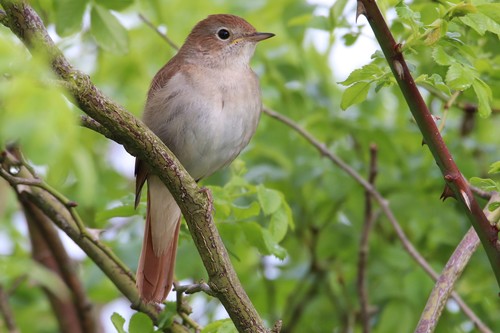
Common Nightingale
The Common Nightingale (Luscinia megarhynchos) is a small, migratory passerine bird famed for its powerful and beautiful song, often delivered at night. It plays a significant ecological role as an insectivore, controlling populations of various invertebrates. Culturally, the nightingale's song has been celebrated in literature, poetry, and music for centuries, symbolizing love, beauty, and melancholy across various traditions. Its inconspicuous appearance belies its vocal prowess, making it more often heard than seen.
15-16.5 cm
Length
23-26 cm
Wingspan
Least Concern
Conservation Status
Distribution
Breeds across Europe and temperate Asia, and winters in sub-Saharan Africa. Migratory routes vary, but generally follow a south-easterly direction in autumn and a north-westerly direction in spring. Altitudinal range extends from sea level to moderately high elevations in mountainous regions during the breeding season.
Lifespan
Typically 1-3 years in the wild, but can live up to 8 years.
Common Nightingale's Habitat
Habitat Types
Dense, low-lying vegetation, Woodland edges, Scrubland, Hedgerows, Gardens with thick cover
Climate Zones
Temperate, Mediterranean, Tropical (during wintering)
Adaptations
Prefers areas with dense undergrowth for nesting and foraging, providing protection from predators. Their relatively long legs are adapted for hopping and running on the ground while searching for food.
Variations
Three subspecies are generally recognized: *L. m. megarhynchos*, *L. m. africana*, and *L. m. hafizi*. These differ slightly in plumage coloration and geographic distribution.
Appearance
Breeding Plumage
Plumage is relatively uniform throughout the year.
Seasonal Feather Changes
Minimal seasonal variation. Juveniles are spotted buff.
Sex Based Plumage Differences
Males and females have very similar plumage; plain brown above and pale below, with a reddish-brown tail.
Notable Features
Plain, reddish-brown upperparts, Pale underparts, Reddish-brown tail, Large, dark eyes, Relatively long legs
Diet and Feeding
Primary Foods
Insects, Spiders, Other invertebrates, Berries (in autumn)
Foraging Behavior
Forages primarily on the ground, hopping and running among leaf litter and low vegetation. It gleans insects and other invertebrates from the ground and foliage.
Specializations
No specific morphological specializations for feeding, but its agility and keen eyesight aid in capturing prey.
Seasonal Diet Variations
Diet shifts slightly towards berries and fruits in autumn, providing energy for migration. During the breeding season, the diet is almost exclusively insects to feed young.
Behavior
Social Structure
Generally solitary or in pairs during the breeding season. May form small, loose flocks during migration.
Communication
Complex and varied song, used for territorial defense and mate attraction, Short, sharp 'tack' calls, used as alarm signals, Hissing sounds when threatened
Migration
A long-distance migrant, traveling between breeding grounds in Europe and Asia and wintering grounds in sub-Saharan Africa. Migration is primarily nocturnal.
Territorial or Group Behaviors
Males are highly territorial during the breeding season, defending their territories through song and aggressive displays. Females may also exhibit some territorial behavior.
Conservation
Threats
Habitat loss and degradation (both in breeding and wintering grounds), Agricultural intensification, Climate change (affecting migration timing and food availability), Pesticide use (reducing insect prey)
Protection Programs
Habitat restoration and management projects, Monitoring programs to track population trends
Local National Laws
Protected under various national and international laws, including the EU Birds Directive.
Population Trend
Decreasing
Population Estimates
Global population estimated to be between 15,000,000 to 28,999,999 mature individuals.
Interesting Facts
The nightingale's song is renowned for its complexity and beauty.
It includes a wide range of whistles, trills, and gurgles, often delivered in a crescendo.
Only unmated male nightingales sing regularly at night.
The nocturnal singing is thought to be primarily for attracting a mate.
Nightingales are often heard but rarely seen.
Their plain plumage and preference for dense cover make them difficult to spot.
They can learn and mimic sounds.
Although not as proficient as some other songbirds, they have been known to incorporate other birds' songs into their repertoire.
Faqs about Common Nightingale
Why do nightingales sing at night?
Unmated male nightingales sing at night to attract females. The reduced background noise at night may also allow their songs to travel further.
Where can I see a nightingale?
Nightingales are difficult to see due to their secretive habits, but you can often hear them singing in areas with dense, low vegetation during the breeding season (late spring and early summer).
What do nightingales eat?
They primarily eat insects, spiders, and other invertebrates. They also eat berries in the autumn.
Are the nightingales endangered?
The Common Nightingale, *Luscinia megarhynchos*, is categorized as 'Least Concern' by the IUCN, meaning that the global population is not currently considered to be at imminent risk of extinction. However, it's important to note that despite this overall classification, nightingale populations are experiencing declines in several regions.
Copyright @ Nature Style Limited. All Rights Reserved.
 English
English